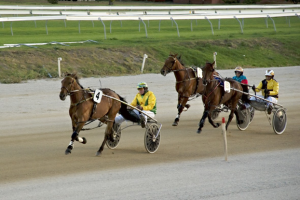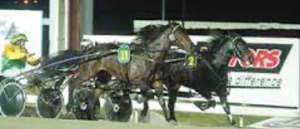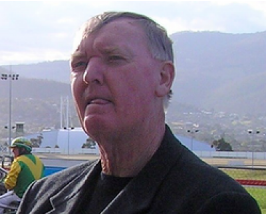Neville Webberley was brought up on a farm and crafted his passion for horses like a lot of people did in those days by riding ponies and breaking them in to sell which allowed him to make a few extra dollars.
As a youngster, he had his heart set on becoming a jockey but it soon became apparent that his weight would be an issue and that is when he turned his hand to the standardbred.
The driver
His first drive was on a horse he also trained named Battle Uhr in 1978 at the tender age of 18 and that same horse also gave him his first winner. From that point forward, the bug had truly bitten him and all he wanted to do was make it in a big way in harness racing.
Neville had a soft spot for Sunshine Jim a horse he drove to victory in the 1981 Easter Cup. This was a huge thrill and also a major turning point in his career. Things really started to take a rapid rise after that as trainers began to realise the ability he possessed.
The following season the talented reinsman charged up the driving ranks with 55 winners and in the process captured the first of his seven state drivers titles. He maintained this progression by winning the next three titles 1983/1984 (63 winners), 1984/1985 (69) and 1985/1986 (81) for a total of four on the trot. He regained the title in 1988/1989 with 65 winners.
He reached the ultimate dream in 1994/1995 when he cracked the magical century by driving 100 winners exactly on route to winning the title and then in 2001/2002 he won the last of his seven overall titles with 63 winners.
Neville won the first of his three Tasmanian Pacing Championships in 1983 on the very talented Lobellent and followed up the next year on one of Tasmania’s finest pacers in Paleface Lyndy. However, it was another eight years before he notched his third win in the race aboard one of the many stars he trained in 1992 winner Thomas Magnum. He was also lucky enough to train the quinella with On Parade running second with Scott Ford in the sulky.

Make a Memory wins the 2009 Tasmanian Guineas.
As a driver, his major interstate success was aboard Lady Allora in the 1990 Victorian Oaks and he was also a very unlucky fourth in the 1994 Inter Dominion Final aboard his favourite horse Halyer, who is still looking for a run today!
His record in the juvenile features is second to none. He captured the Tasmanian Derby on three occasions aboard Halyer (1990), Thomas Magnum (1991) and Whisky Regal (1993). He won four Tasmanian Oaks as a trainer and three as a driver with Arcadia Neptune (1988), Roses Heart (1992), Goldeena (1994) and Ultimate Girl (1996). He also trained the Oaks quinella in 1996 with Marlee Jayne finishing runner up to her stablemate.
He has won nearly every feature race on the calendar including multiple two-year-old classics such as the Dandy Patch, Evicus and Sweepstakes along with numerous Sires Stakes races in Tasmania and interstate in a brilliant driving career which spanned over 33 years and resulted in 1369 winners nationally.
So it was no surprise to see Neville be one of the first inducted into the harness racing Hall Of Fame in 2014 alongside his old rival Barrie Rattray and now the state’s all-time leading reinsman, Ricky Duggan.
The trainer
While he was fortunate enough to have plenty of superstars come through his stable in a brilliant career, it was as the trainer of young horses that really set Neville apart. He made a point of emphasising that his stable was primarily about winning the two and three-year-old features both locally and at a national level and the results speak for themselves. In one season Neville trained 14 individual two-year-old winners which is a testament to his horsemanship.
He also enjoyed the challenge of taking horses that were struggling to win one or two races into winning multiple races. He believed he had accomplished his role as a trainer if he could achieve that.
He got to know each individual horse and was able to build a bond with them. He would employ various techniques to achieve this but found that things such as jumping on their back and going for a ride in the bush or just giving them some additional care seemed to work wonders.
The horses
Halyer
His favourite of all time was a Kotare Knight yearling who turned up at his stables in 1987 who later became known as a Halyer (aka Bobby) and what a ride this horse took Neville on. In a brilliant career, he matched it with the best in the land and it was in 1990 after he won the Tasmanian Derby at the Showgrounds easily, he then headed to Harold Park for the NSW Derby and Webberley was very confident he would acquit himself well. As history now shows he would get very close to the eventual winner Imprimartar, apart from pacing roughly over the concluding stages resulting in Neville getting a month’s suspension.
After that unlucky second the best was yet to come. At his next start he ventured across the Nullabor to Perth to take on Australia’s best three-year-old pacers in the Australian Derby. He fronted up with John “Bulldog” Nicholson in the gig as Neville was on the sidelines and gave his rivals a pacing lesson to win brilliantly running away from Nero’s Son with Bulldog waving the whip 50m from home with the win described by Webberley as one of his greatest training highlights.
Returning back home as a four-year-old, Webberley knew he was in for a special ride.
“This horse will take me to heights I never imagined,” Webberley recalled.
“He was brave running a gutsy second to another Tasmania champion Thorate in the 1990 Tasmanian Pacing Championship, but he injured himself in the run which resulted in him having to be tipped out for about 12 months which was a real shame as he was at the peak of his career,” Webberley said on a campaign that didn’t have the happy ending he had hoped.
Halyer returned to win the 1992 Easter Cup beating a very strong field boasting some grand circuit performers like Franco Tiger.
Despite not being 100% sound, Neville decided to take Bobby for a tilt at the 1994 Inter Dominion.
“We ventured up to Harold Park where Bobby won his first heat which was followed by two placings in the remaining heats.
“Bobby had qualified for the final and was a live chance but just needed a bit of luck in the run but unfortunately luck was not on his side. Just like it eluded him four years earlier in the NSW Derby. He finished a very unlucky fourth as he just never got a crack at them but I can say if he did I’m sure he would have just about won the Inter Dominion,” said Webberley.
Halyer returned home and was retired on a fitting note after winning a Free-For-All in September 1995 as a nine-year-old. He was owned by Don and Dean Cooper throughout his career and will be remembered as one of the true greats of Tasmanian Harness Racing.
Thomas Magnum
Thomas Magnum was another very gifted pacer that Neville had the privilege to train. After winning only one of his first five starts, Thomas went on to win 17 out of his next 19 starts. During this period, he captured the Sweepstakes Final as a two-year-old and the Tasmanian Derby as a three-year-old with the pinnacle of his career coming in 1992 when he took out the Tasmanian Pacing Championship beating a quality field which included Thorate.
Lourdes
A mare called Lourdes is one that sticks with Webberley among the very best.
“Lourdes was the best mare that I trained who never missed running first or second under my care and won three feature races,” said Webberley.
She won the Bandbox stakes as a three-year-old and returned as a four-year-old to beat the open class pacers in the Golden Mile defeating another champion from the Apple Isle in Flashing Red. A week later, she lined up in Tasmania’s best mares race, the George Johnson and won easily. After that run, she was sold to American interests.
“If she had stayed in Tasmania, I’m comfortable she would have measured up to Australia’s best for sure” stated Webberley.
Dare We Dream
Dare We Dream was just an outstanding juvenile who won his first 11 starts including every juvenile feature. He was beaten for the first time in the Tasmanian Guineas by the NSW colt Dereks Pick who came to Tasmania with an imposing record.
He contested the Tasmanian Derby two weeks later where he was beaten a nose by Australia’s best three-year-old at the time in Divisive and a week later, Dare We Dream lined up in the Australian Derby where he again met Divisive and he ran a great second.
“It was certainly no disgrace to be beaten by him,” said Webberley.
“But in saying that, Divisive did draw inside us on both occasions.”
Dare We Dream pulled up sore after those races with a leg issue which Webberley describes as a real setback for the campaign.
“We had our work cut out getting him up and ready for the upcoming Sires Stakes for the three- year-olds which was only four weeks away.
“The horse shone in that series winning both the heat and final, but the sad thing was that it was the last time we got to see a very gifted pacer.”
Dare We Dream finished with a career record of 14 wins and three seconds from 17 starts.
Neville commented on a few other quality performers who have competed in the famous green and gold colours.
Almeta Boy
“Very good horse who had plenty of high speed but went to Vin Knight as a three- year-old and raced in some of the best races in the land.”
Lady Allora
“Outstanding juvenile who won the Tasmanian and Victorian Oaks, but her rough gait was an issue and stopped her from reaching the heights she should have.”
Whisky Regal
“Very good young horse who won the Tasmanian Derby and other races interstate.”
Jurassic Jack

Colsta winning the 4YO Globe Derby final.
“As good as any two-year-old that I ever had but his bad gait cost him getting to loftier heights.”
Colsta
“Very good horse and we thought the sky was the limit with him but unfortunately broke down prematurely.”
Goldeena
“Really good mare who won the Tasmanian Oaks and also acquitted herself very well on the mainland.”
Ultimate Girl
“Was a very nice mare who won most of the best juvenile races in this state. She’s one of the most honest and versatile horses I trained.”
On Parade
“He was a very good horse but unfortunately came up against Thomas Magnum and he did run second in the Tasmanian Pacing Championship. He went on to compete with great distinction interstate.”
Col Johnstone
Neville emphasises how thankful he was to have forged a relationship with one owner in particular. Col “Wobbler” Johnstone.

Col Johnstone pictured after Dream Catch Me was successful in the Prince Of Pace.
“Wobbler was one of my most loyal owners who then became one of my closest friends and still is until this day.
“Col and Allen Williams had horses with me when they had Thorate Lodge at Deloraine and we were able to pull off a few good betting plunges with horses such as Colonial Speed and Marlee Jayne. Then after Allen’s sad passing, Col and I built up a great partnership until my premature retirement,” recalled Webberley on how the partnership started.
“Marlee Jayne excelled as a broodmare producing many quality horses that Col and I raced in partnership. The first of her progeny was Lourdes, who was followed by Colsta, Dare We Dream, Dream Catch Me and Make A Memory just to name a few,” said Webberley.
Tasmanian racing overview
Neville still keeps an eye on Tasmanian harness racing these days but looking back to the time that he was actively involved it is easy to see the differences.
“Back in the good old days of the 1980’s and 90’s the competition was fierce and there were plenty of locally bred horses who were stars on the track.
“One of the decisions that was made back then was to change the format of our feature races and to stop running heats which meant some of the best pacers in Australia could race for over $100k in prizemoney simply by flying in and flying out with our prizemoney.
“Previously, they had to run in preludes to qualify for rich races such as the Championship, Easter Cup or Derby. This made it hard for the local owners and breeders to get any of the prizemoney in those races and that made a few breeders and owners walk away back in that era.” Webberley said.
Looking at the current state of harness racing, Neville bemoans a lack of quality youngsters coming through the ranks as a potential hinderance to racing’s development.
“I have been out of the game for over 10 years now, but I still keep my eye on local racing. The one thing that really stands out, which is not great for our industry is the lack of young horses coming through the ranks. I know there are not the breeders around like there used to be, but it is a concern. Owners should get back into supporting two-year-old racing as that’s where all our good horses come from,” Webberley said matter of factly.
“The other thing I have noticed is the amount and types of horses that have been arriving from interstate, especially claimers, which I don’t agree with as it has severely impacted the quality of our racing in recent times which is a backward step in my mind,” Neville added.
“I can see why trainers and owners are sending their horses interstate once they reach a certain mark locally as they get starved of opportunities here and need to see if they can measure up in the stronger class races.
“Tasmanian horses have had huge success interstate over recent years with the calibre of horses such as Beautide, Devendra, Our Chain Of Command, Barynya, Shez Ryleymak and Ignatius all winning feature races which is great to see as back in my day you would travel everywhere if you had one capable of competing at the top level,” said Webberley on some of the best to come out of the state in recent times.
Barrie Rattray
Neville forged a great rivalry with Barrie Rattray on the track which no doubt pushed both to a higher level.
“He was a great trainer/driver and my toughest opponent who had some great people around him as his father Wayne is someone I respected immensely.
“So, with that experience it made him very hard to beat but I thoroughly enjoyed the challenge because of our fierce rivalry it made us by far better trainers,” said Webberley about the competition.
“It is great to see that Barrie and his family have finally got that good horse in Beautide which makes all their hard work worthwhile. I wish him all the best in the future.
“Our battles in the late 80’s and early 90’s was always very competitive and that’s what’s racing is all about,” added Neville enthusiastically.
Speaking from the other side of the coin, Barrie Rattray echoed Webberley’s sentiment about their battles.
“Neville was an extremely competitive person who I enjoyed beating but was more than happy to be beaten by.
It was how a contest was meant to be, tough on the track and mates off the track. We would give no quarter and take no quarter,” Barrie Rattray said.
Barrie’s father Wayne is also in the Hall of Fame and speaks positively about what Webberley brought to all facets of harness racing.
“Neville was one of the most gifted horsemen I had ever seen as he was the complete package. He was farrier, trainer, driver, and maybe even a bit of a horse whisperer.
“But all in all he was a fierce competitor of mine and my son Barrie and as we all know Nifty and the Rattrays both loved to win and that’s what our battles so unique” said Wayne Rattray.
Closing
Fellow Hall of Famer Ricky Duggan also tributes Webberley’s horsemanship as a big reason for his success.
“One of the most gifted real horsemen that I have ever seen, Tasmanian Harness Racing is a lot poorer for his absence,” said Ricky Duggan.
Neville Webberley doesn’t currently have any active involvement in racing which may change but Neville doesn’t think it is highly likely.
“I won’t say no as you never know what life brings you.”
Neville Webberley will go down as one of the all-time greats of the Tasmanian Harness Racing Industry and he will sit up in the top echelon as his record just shows what a genius he was with a standardbred.